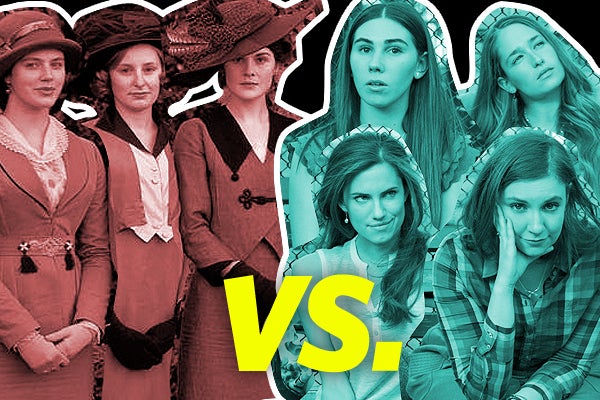
Whether it’s a pastoral manor in Edwardian England or New York City in the 21st century, being a female in one’s early 20s is all about identity. For us ladies, it’s the time when, as Hannah says on Girls, most of us are “busy…trying to become who [we are].” Unfortunately, you can’t call a time-out on life to figure out all the problems the world is throwing at you. You’ve just gotta keep on moving forward…despite suddenly realizing how monumental all decisions are now that you’re making them as an adult. For the quartet of friends on Girls and the three ladies of Downton Abbey, the course to self-actualization has already been charted by the world into which they were born. Yet, it’s the intersection between circumstance and character where things get interesting.
Look, the worlds of Downton Abbey and Girls are incredibly different, but the archetypes of the characters in both shows are universal. There’s Hannah, who may come across as a hot mess but is actually quite self-assured and confident when it comes to her own opinions and moral compass; Marnie, the type-A, put-together gal whose deep insecurities only surface in times of great emotional turmoil; Jessa, the free spirit quickly tiring of her own selfish ways while finally realizing that her actions actually affect other people; and Shoshanna, whose overeagerness to please and do the socially acceptable thing have become her entire anxious personality.
Over at the Abbey, Lady Mary is a total Marnie — she’s pretty, well-attired, and completely lost when things don’t go as planned. Edith is a mix of Hannah and Shoshanna: As the middle child and also the least conventionally beautiful, she’s used to getting passed over for her sisters. As a result, she’s overly eager to please (just to get some attention), but with the hardened opinions of someone for whom life, thus far, has felt most unfair. Youngest daughter, Sybil, is the Jessa-like free spirit of the family — although she is naturally more inclined to help others — running off to marry the man of her choosing despite the impact it has on everyone at Downton.
All television series start with a cataclysmic shift in the show’s universe that forever alters the characters’ lives and the fundamental truths around which they all orbit. On Girls, it’s Hannah Horvath’s parents cutting her off financially. On Downton Abbey, it’s the sinking of the Titanic, which essentially results in the same predicament for the Ladies Crawley. As females in 1912 England, Mary, Edith, and Sybil are unable to inherit the only home they’ve ever known. When the next heir in line goes down with the Titanic, the sisters’ futures are suddenly uncertain.
As women raised in a certain social class with a well-charted series of life events and expectations, all of the characters on Downton and Girls start off with the strong sense of self one gets when life has already been mapped out. When the rug is pulled from beneath them, the possibilities the future holds are suddenly endless and paralyzing. Whereas before all the women were guaranteed “success” only by filling the obvious check boxes set out for them by nature of birth and family history, everything is now hazy.
Upon learning that her intended fiancé and assured ascendence to the Downton throne went down with the Titanic, Mary impetuously asks her father, “I don’t have to go into full mourning, do I?” Similarly, Hannah scoffs at her parents, “I could be a drug addict. Do you realize how lucky you are?” Those are the rash responses of people with a limited worldview suddenly confronted with changes that require major action and decisions. Mary’s future in Downton and guaranteed husband have vanished. Hannah can no longer be an unpaid intern who writes essays when she feels like it.
On the flip side, there’s Anna May Bates (née Smith). While she isn’t a Crawley, her life is actually one that the cast of Girls (and we modern women) can relate to. As the head housemaid, her life is about work, duty, and her job title — and until Mr. Bates comes along, her identity is constructed entirely around her career. Much like Shoshanna, who never saw herself in the context of anyone else (especially a man). But as love comes into the lives of each of the girls, both learn that being a “modern” woman can involve both relying on yourself and allowing yourself to rely on others.
For all the characters, these are the moments when the adventure truly begins. They may come from well-off families and have a good education, but times and circumstances change, and their clearly marked paths are gone. Their lives are now open-ended questions, and this is the crux upon which both shows operate. How Hannah, Mary, Marnie, Edith, Jessa, Sybil, and Shoshanna respond to the free fall of their 20s, compounded by the uncertainty and upheaval of having to choose their own destinies, is why we’re glued to our screens every Sunday. “I think she’s going through some kind of adjustment into adult life,” Hannah tells Adam on a particularly surly Marnie morning. We all are, dear. Here’s to staring into the great unknown.
Designed by Isabelle Rancier
Click HERE to read more from Refinery29.

Be the first to comment